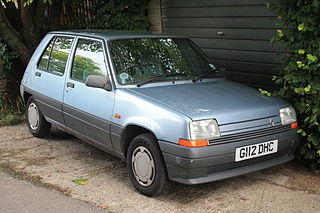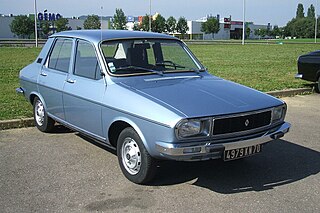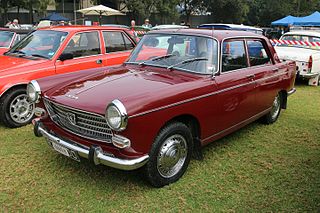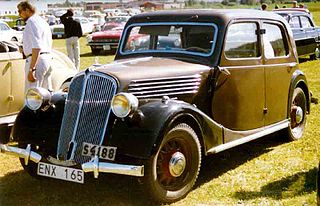
Panhard was a French motor vehicle manufacturer that began as one of the first makers of automobiles. It was a manufacturer of light tactical and military vehicles. Its final incarnation, now owned by Renault Trucks Defense, was formed by the acquisition of Panhard by Auverland in 2005, and then by Renault in 2012. In 2018 Renault Trucks Defense, ACMAT and Panhard combined under a single brand, Arquus.

The Renault 5 is a five-passenger, three or five-door, front-engine, front-wheel drive hatchback supermini manufactured and marketed by the French automaker Renault over two generations: 1972–1985 and 1984–1996.

The Renault 12 is a mid-size family car introduced by French automaker Renault at the Paris Motor Show in October 1969 and produced in France until 1980. Available as a saloon (Berline) and estate (Break), it was also produced under licence in many countries around the globe into the early 21st century.

The Renault Laguna is a large family car that was manufactured and marketed by Renault for 21 years in three body styles: hatchback, coupé, and estate. The first generation Laguna was launched in 1994, the second generation was introduced in 2000, and the third generation was built from October 2007 until 2015.
Berliet was a French manufacturer of automobiles, buses, trucks and military vehicles among other vehicles based in Vénissieux, outside of Lyon, France. Founded in 1899, and apart from a five-year period from 1944 to 1949 when it was put into 'administration sequestre' it was in private ownership until 1967 when it then became part of Citroën, and subsequently acquired by Renault in 1974 and merged with Saviem into a new Renault Trucks company in 1978. The Berliet marque was phased out by 1980.

The Renault 21 is a large family car produced by French automaker Renault between 1986 and 1994. It was also sold in North America initially through American Motors dealers as the Renault Medallion and later through Jeep-Eagle dealers as the Eagle Medallion. A total of 2,096,000 units were produced.

The Peugeot 404 is a large family car produced by French automobile manufacturer Peugeot from 1960 to 1975. A truck body style variant was marketed until 1988. Styled by Pininfarina, the 404 was offered initially as a saloon, estate, and pickup. A convertible was added in 1962, and a coupé in 1963. The 404 was fitted with a 1.6 litre petrol engine, with either a Solex carburetor or Kugelfischer mechanical fuel injection or a 1.9 litre diesel engine available as options. Introduced at the Paris Motor Show as an option was the inclusion of a 3-speed ZF automatic transmission, similar to the unit already offered on certain BMW models, as an alternative to the standard column-mounted manual unit.

De Dion-Bouton was a French automobile manufacturer and railcar manufacturer, which operated from 1883 to 1953. The company was founded by the Marquis Jules-Albert de Dion, Georges Bouton, and Bouton's brother-in-law Charles Trépardoux.

Delage is a French luxury automobile and racecar company founded in 1905 by Louis Delâge in Levallois-Perret near Paris; it was acquired by Delahaye in 1935 and ceased operation in 1953.

The Simca 1100 is a series of French compact family cars – mainly C-segment hatchbacks, but also a compact wagon and popular delivery vans – built for over 15 years by French car-maker Simca, from 1967 through 1982/1985. There was even a very early 'hot hatchback', and a family cross-over: the Matra Simca Rancho. The hatchbacks were replaced by the Simca-Talbot Horizon.

The Renault 18 is a large family car produced by French manufacturer Renault between 1978 and 1989, with South American production continuing until 1994. It formed the basis for the closely related Renault Fuego Coupé, with which it shared its floorpan and drivetrain, but with the Fuego initially using the negative offset type front suspension from the larger Renault 20/30, which became standardized across the 18 range from the 1983 model year onwards.

The Fiat 518, also called Fiat Ardita, was a model of car produced by Italian car manufacturer Fiat between 1933 and 1938. The name "Ardita" was also used on the six-cylinder engined and more expensive Fiat Ardita 2500 or 527.

The Renault NN, generally known to contemporaries simply as the Renault 6 CV, is a compact car or small family car manufactured by Renault from 1924 until 1930.

The Renault Primaquatre is an automobile produced from 1931 to 1941 by Renault. It was the last car built before Louis Renault's death in 1944.
Buchet was a French motorcycle and automobile manufacturer between 1899 and 1930.

The original Citroën Rosalie was a light-weight racing car that established a succession of records at the Montlhéry racing circuit. More generally the Rosalie was a range of three models/sizes of automobile that comprised the core of Citroën's model range between 1932 and 1938. The three models were originally designated respectively the 8CV, the 10CV and the 15CV, the numbers defining the cars' fiscal horsepower which in turn defined the approximate engine size of each model. After the introduction of the new Traction Avant, the lineup was modified and at the 1934 Paris Salon the two smaller models became the 7UA and the 11UA, now with the overhead-valve engines from the Traction. Starting with the 1933 model year Citroen offered the 1,766 cc 11UD diesel engine option.

The Monaquatre was a small family car assembled by Renault between 1931 and 1936. It used a conventional front-engine, rear-wheel-drive configuration and was powered by a four-cylinder water-cooled engine.

The Renault Monastella was a compact luxury car manufactured between late 1928 and 1933 by Renault. It shared the mechanical elements and bodywork options of the Renault Monasix but was differentiated by superior levels of finish and equipment.

The Peugeot Type 177 B was a mid-range car produced between 1924 and 1929 by the French auto-maker Peugeot. With a fiscal horsepower of 10 CV, and a wheel base of 2670 mm, it competed in the same sector as the Citroën B2 and Renault KZ.

The Novaquatre is a car first presented in the autumn of 1937 by Renault and produced until 1940. It was presented in 1937 as an economy version of the Primaquatre, combining the body of the little Renault Celtaquatre, with the 2383 cc 4-cylinder water-cooled engine of the larger Renault Primaquatre.



















